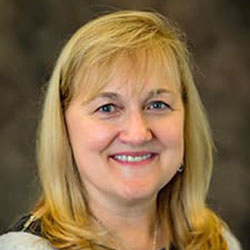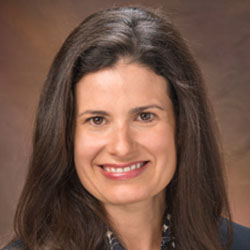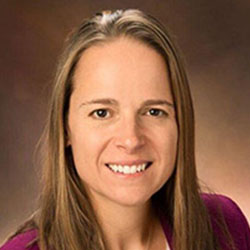HOW CAN WE HELP YOU? Call 1-800-TRY-CHOP
In This Section
From Mentors to Making it Your Own: Inspiration From Women in STEM

Celebrate Women’s History Month with us, as individuals in STEM nominated by their Centers of Emphasis share their research projects and words of wisdom.
“Take your passion for science, engineering, technology, or math, and change the world,” said Ayana Bradshaw, MPH, administrative director of the Center for Injury Research and Prevention (CIRP). These words of advice, aimed toward aspiring female scientists, are just some of the inspirational insights featured in this year’s gallery of women in STEM at Children’s Hospital of Philadelphia. Alongside Bradshaw, the CHOP Research Institute is home to a remarkable number of role models for women in STEM – individuals who thrive in areas that have been historically underrepresented by women and who continue to lead their fields by conducting groundbreaking research and challenging the status quo.
To celebrate Women’s History Month, we once again asked our Center of Emphasis leaders to nominate one or two such individuals to share their stories and successes in a two-part Cornerstone series. The resulting list, of which this is the first installment, features nominees from a variety of career levels and walks of life. Directors and doctors, students and senior scientists have offered their experiences and advice – whether it’s to seek out spaces that allow for authenticity, articulate the innovativeness of one’s research, or even sing out confidently in the middle of one’s kitchen! Read on to meet seven of this year’s nominees, and stay tuned for our second installment featuring even more nominees.
Nancy Kassam-Adams, PhD: “Love the questions.”
Associate Director for Behavioral Research, CIRP

Nancy Kassam-Adams, PhD
For the past 20-plus years, my research has focused on understanding traumatic stress reactions in children and parents after medical events and other difficult experiences and developing ways to promote emotional recovery. My current research is in two areas: testing new online tools to monitor children’s recovery and keep parents informed, and developing methods for data sharing and harmonization. We are working to bring together datasets from traumatic stress studies around the world to help advance science in this area.
I love working on things that are intellectually interesting and challenging, but that also have a direct line to making people’s lives better. My research always has involved a lot of multidisciplinary and international collaboration, which is both rewarding and a lot of fun.
Figure out what questions you really want to ask, and how these questions could have an impact in the world. It’s really important to love the questions and feel that what you’re doing makes a difference, because much of the nitty-gritty day-to-day work of science and research is not glamorous or immediately rewarding.
I love that doing science (psychological science, in my case) involves a lot of different parts of my brain – quantitative/analytical as well as human/interpersonal. For young women: STEM needs you. Science needs all the voices and all the communities to be present. When we limit who is at the table, our questions and our science are just not as good.
Denise Adams, MD: “Make it your own.”
Director, Comprehensive Vascular Anomalies Program and Investigator, Center for Childhood Cancer Research

Denise Adams, MD
My research is focused on the study of vascular anomalies, which are rare diseases made up of tumors and malformations. I became interested in studying these disorders because of the lack of access to treatment and care for these patients. Their quality of life was suffering from these chronic, progressive, and sometimes life-threatening disorders with limited scientific knowledge and lack of evidence-based therapies.
My mission was to work with clinical and scientific investigators to improve the outcomes for these patients. We built interdisciplinary programs to provide excellent clinical care and develop a research infrastructure for drug development. In the past five years, by working collaboratively, major advances have occurred in this field, and we now have more medical therapies based on scientific evidence.
My advice for young woman interested in pursuing STEM career: Do not be afraid to take hold of an opportunity that may not be on your “perceived path.” Grasp it, take charge, and make it your own. Think of it as a challenge for discovery and the possibility to make an impact on your life and lives of others. Surround yourself with others who will support and mentor you, and then give that gift to others. Take a moment to stand on a chair in the middle of your kitchen and sing, “I am woman hear me roar!” Teach your daughters to do the same!
Ayana Bradshaw, MPH: “The possibilities in STEM are limitless.”
Administrative Director, CIRP

Ayana Bradshaw, MPH
I’ve had the pleasure of working at CHOP for 14 years, specifically in the role of Center Administrative Director for CIRP and the Center for Violence Prevention. Through this role, I oversee the Center’s administrative operations and experience firsthand the endless possibilities in STEM. I work alongside some of the most brilliant and passionate scientists and practitioners in the world. As a public health practitioner, my lifelong passion has been to improve health outcomes for all. I’m extremely proud that through my administrative oversight, I’m able to support the impact that our work has in ensuring the safety and well-being for children and families.
The possibilities in STEM are limitless. You are capable of creating the next innovative technology, communicating science through your art or writing, or using statistical methods to document health trends to identify emerging health issues. STEM careers have been characterized as a male-dominated field for so long that we may allow fear and intimidation to take control of our full potential. I encourage you to take your passion for STEM and change the world. If you keep your eyes on the prize, you can achieve goals beyond your wildest dreams.
Jenea Adams: “Find your voice.”
Researcher, Center for Computational and Genomic Medicine

Jenea Adams
I’m a computational biologist, so I work at the intersection of mathematics, computer science, and biology. I use these fields to build new tools for better analyzing pediatric cancer data, so that we can improve personalized medicine approaches for affected children with developing bodies, genomes, and bright futures.
I would tell young women interested in STEM to find their voice and hold onto it so that you can let it shine. Seek out and hold on to spaces that allow you to show up authentically as yourself, so that you can grow and thrive to be the scientist you want to be.
Lisa Schwartz, PhD: “Identify mentors who support and nourish your ideas.”
Psychologist, Division of Oncology and Investigator, Center for Childhood Cancer Research

Lisa Schwartz, PhD
My research mostly focuses on self-management of adolescent and young adults (AYA) impacted by cancer, and it includes digital health interventions and longitudinal observational studies. AYA survivors, in particular, are a unique population trying to move on with their post-cancer life, yet they often face significant morbidities and health vulnerabilities. Having had cancer can be a teachable moment to improve health behaviors and plan for transition to adulthood and adult follow-up care.
While AYA can be challenging to research, it is rewarding when an AYA benefits from an intervention or feels valued as a research participant. I am working on expanding this work on self-management, including health promotion and transition to adult follow-up care, to AYA with cancer predisposition, which is a relatively new area of behavioral oncology research.
Most importantly, identify strong female mentors who can support and nourish your ideas, and serve as a role model of persistence, commitment, and balance. Also, work to make connections and build collaborations both within and outside the institution. Mentors can help with this. Finally, consider the fundability of your ideas; make sure to shape research aims to fit with specific grant mechanisms and topics of interest of funders, and articulate how your research is innovative and necessary to advance your field, yet is also generalizable.
Heather Burris, MD, MPH: “It is a privilege to have work overlap with passion.”
Neonatologist, CHOP Newborn Care and Investigator, Clinical Futures

Heather Burris, MD, MPH
I am a practicing neonatologist, meaning that I care for sick infants in the intensive care unit. In our country, there are large inequities in the chance of giving birth to a healthy baby. Black infants are 50 percent more likely to be born preterm and twice as likely to die before their first birthday than white infants. This unjust disparity is due to longstanding differential exposures to social and physical toxicants as well as health-promoting environments that affect the risk of adverse health outcomes. Yet, we still do not know how these exposures affect pregnancy physiology. My team works on this question with the goal of assisting policymakers and providers to decide what interventions would have the largest impact on reducing disparities in birth outcomes.
As a physician-scientists, we are so lucky to get to care for the patients in front of us, as well as to ask and answer questions in an attempt to improve the health of patients beyond our direct care. As a lover of math, science, writing, and people, a career in medicine and science is ideal. It is a privilege to have work overlap with passion. If we find that sweet spot and follow it through the ups and downs, there will be no regrets.
Lindsey George, MD: “Grit is important.”
Physician, Division of Hematology and Investigator, Raymond G. Perelman Center for Cellular and Molecular Therapeutics

Lindsey George, MD
My laboratory-based research aims to study the molecular basis of coagulation with the goal that we may be able exploit basic biochemical understanding of hemostasis to develop novel therapeutics for disorders of hemostasis or thrombosis. In particular, we are interested in coagulation factor VIII, the deficient protein in hemophilia A, with the goal that some of our studies may advance efforts in hemophilia A gene therapy.
I am also the clinical PI of ongoing hemophilia A and B gene therapy trials and am working to establish clinical trial infrastructure for other investigators to similarly conduct in vivo gene therapy clinical trials. Long-term, my goal is to develop gene therapy methods that could be used to successfully treat neonates with hemophilia (current efforts are only geared toward adults) with the goal that those efforts may be broadly applicable to a variety of monogenic disorders.
Grit is important; you will fail more often than you succeed, and that’s OK. It’s most important that you learn why you stumbled and incorporate that knowledge into the next iteration of your work.
Editor’s Note: We’re not done yet! Stay tuned for more voices of CHOP women in STEM in our second installment of this series.
Deanne Taylor, PhD: “Develop a vision.”
Director, Bioinformatics in the Department of Biomedical and Health Informatics (DBHI)

Deanne Taylor, PhD
My role at CHOP is Director of Bioinformatics in DBHI, and I have a Research Assistant Professor position in the Department of Pediatrics at University of Pennsylvania’s Perelman School of Medicine.
Develop a vision of where you want to go with your scientific life and career and actively seek out well-established mentors whom you can trust to advise you on the best way to get to that place. With advice on how to navigate the roads to your future, you may be surprised to find that the right choices along the way will make the journey that much easier. With that in mind, don’t be afraid to reach out for advice, even to people you don’t know well. Often just being someone who proactively reaches out to others can lead to the development of opportunities you would never have dreamed of otherwise.
Editor’s Note: We’re not done yet! Stay tuned for more voices of CHOP women in STEM in our second installment of this series.